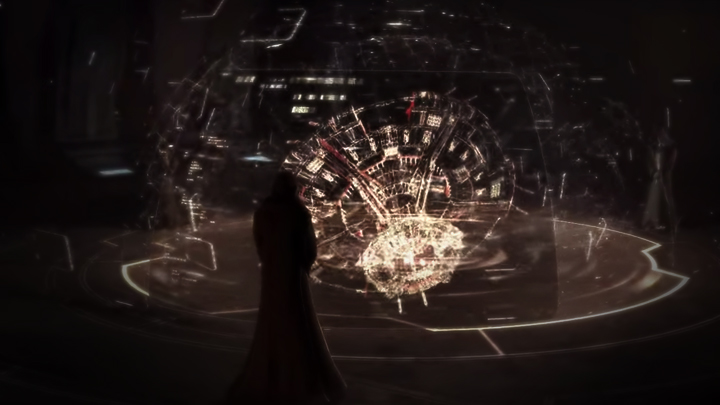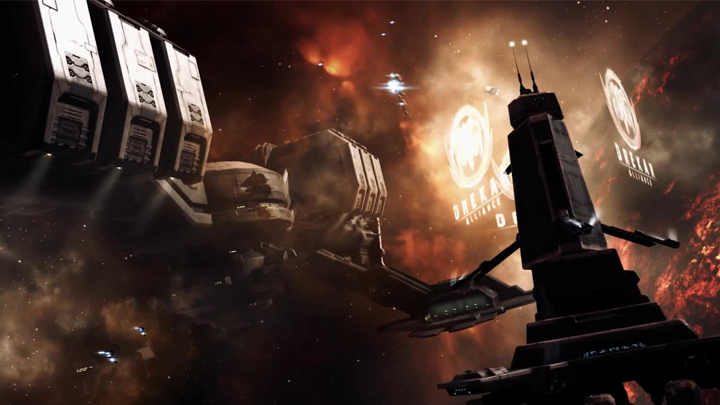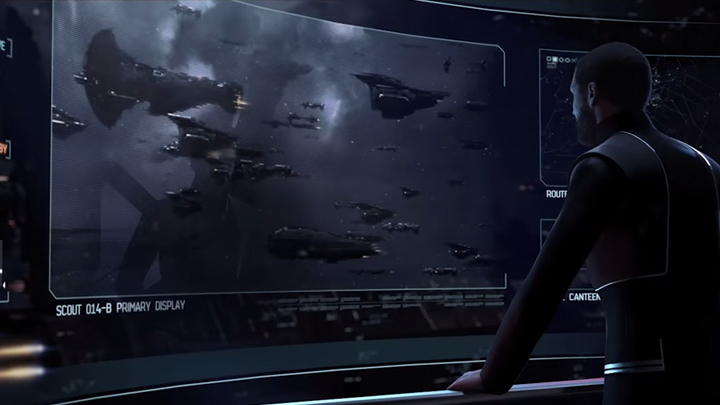Fellow contributors: Amymuffmuff, Hona Chaginai, Gyrn Fzirth, Tridgit and others at EN24
New sovereignty mechanics have been announced in a devblog authored by CCP Fozzie. The subject is important enough that he released two devblogs; one was a state of the sov game, and the other was the new sov mechanics. These new mechanics will affect tens of thousands of players, so they are highly anticipated but won’t show up until the June expansion and will likely go through several iterations before they are finally released to Tranquility.
This will be known as ‘Sov 3.0.’ In the original sov grind, aka ‘Sov 1.0,’ sovereignty of an individual system was determined by having the majority stake of towers on moons in that single system. That changed in Dec 2009, in the Dominion expansion, to the system we have now, (Sov 2.0) which involves setting Territorial Claim and Blockade units. The failure of both systems was the same: Null was dominated by groups that came up with “max numbers” or capital fleets, or both. First, the fleets would fight, then the victors would grind down the structures in safety, secure in the knowledge they had driven the opposing force from the battlefield.
Given a player’s desire to win at all costs, natural differences in culture, leadership, style are not incentive enough to disperse into smaller, less centralized, groups. Corporations naturally gather into alliances, which then treaty to make coalitions, who subsequently ally with other coalitions; this progression is normal if winning is a higher priority than identity. This is what broke null-sec. The desire to not lose. Null-sec players have painted themselves into a corner and asked for help because they could not naturally play to “not win.”
The “Null Deal,” was proposed by TheMittani.com and signed by most of nullsec sov holders at the time:
Occupancy-based sovereignty
NPC space in every 0.0
Value of individual systems increased
CCP didn’t capitulate to the request as they considered it ‘still thinking inside the box.’ Capital fleets and blobbing would still win the day, every time. FCs would still think for everyone else, and ‘bears could pitch-in by ratting when not pressing F1 for the FC they orbited. Again, all this is natural when you consider the progression and investment players make over a span of years. But, under the Null Deal, nothing would change for the unabsorbed “little guys.”
The solution was to change the entire dynamic of warfare and the holding of sovereignty. If anything, the nulldeal spurred CCP to move faster and they made the easiest single change they could to most significantly affect power projection: nerf jump travel with range reduction and the newly-introduced fatigue mechanic. That was phase one. Now, CCP’s vision for phase two has been revealed with widespread implications.

CCP had to step in and change the sov model entirely to accomplish several things:
Fun – make other types of players important too (scouts, jr fc’s, ratters, indy)
Understandable mechanics – understandable by all, not just the initiated in guild-like sov clubs
Minimize blobbing & over-shipping – taking the win button from large coalitions
Reduce time and effort to acquire sov
Occupancy benefits for living in space – bottom up bonuses
Spread out battles – help server load and more dynamic battles
Must be flexible to updates, so it can evolve as needed
Current sov holders will start out by owning their current territory, and declaring a four hour “prime time” window in which their sovereignty structures are vulnerable. Structures can only be re-secured by proper alliance members through a key-like mechanic, thus allies can only help by establishing military control over an area, ensuring the defending alliance members can secure their structures in peace.
An alliance sees which structures are vulnerable, sends a patrol to re-secure a given structure, and when their “prime time” is over, they can rest until tomorrow. If opponents bring their own key they can “unlock” the vulnerable structures which reinforces. Reinforcement means that the structure will spark a “capture event” (see below) 48 hours. The winner of the capture event for that structure achieves their goal – to destroy or re-secure the structure. Stations are treated differently since they cannot be destroyed. Station services are always vulnerable and addressable however, and are hacked and repaired the same way, with a key.
The overall theme is for fleets to fight each other, not to shoot structures. The old model of clearing the field for capitals to come in and remove the structures is going away.
The Entosis link is a new module you mount in a high slot on your ship. It is partially made of Drifter elements found in their wreckage and when used it makes you vulnerable and unable to receive effects from your fleet mates, but you can still move and use modules. Basically, you must stay on in range of structure and keep yourself alive. The link projects a bright light for all to see, so you will immediately be a target, at the mercy of foes fighting around you. This is where allies can help.
Once the link’s cycle is complete, the structure starts a reinforce timer: A 10 minute countdown (not counting defensive bonuses and TIDI effects actual time). If the timer reaches its conclusion, you get the result you were looking for. However, if an opponent shows up and uses his link on the same structure, it becomes a race to see whose timer finishes first. When both keys are in place, the race is paused. To make progress you have to destroy your enemy’s keys and see your countdown to the end. More than one key can be used at the same time, but the advantage is redundancy, not increased speed. It only takes one ship with one link to destroy a structure or put a station in jeopardy. To conquer a station takes a bit more (keep reading).
Timers
Defending alliances get to set their own “prime time” which will probably be when most of them are on. That time is a four hour window that opens daily, wherein any of their sov structures in their holdings are vulnerable. Like a fire department, they need to send patrols out to re-secure those structures, or they can sit by letting the time expire, closing the window. Outside of the stated “prime time” for an alliance, all of their structures are invulnerable. Alliances with multiple time zones will have to determine when they are strongest, and oblige the other TZs to be their offensive arm.
This mechanics also has a constricting effect on the size of sov holdings – the more assets you have, the more you have to defend. Each defense requires at least one pilot that becomes semi-vulnerable when re-securing a structure. Alliances will likely send a ship with the link accompanied by other fighters, increasing the chances of surviving skirmishes. Pilot distribution will overwhelmingly favor important station saves which require many more pilots.
When a structure has been successful keyed, the owners get an alert and the 10-to-40 minute countdown, depending on the defenders’ occupancy bonuses as described later in this article, begins. Remember, this is their “prime time.”

When a structure comes out of reinforce it spawns a “capture event.” If the capture event is won by the invaders, the structure is destroyed, except for Stations. Stations are the jewels of null-sec and get special treatment: If the defender wins, the station is re-secured and everything is back to normal. If the attacker wins the sov hold is broken, and the station enters a sov-less state called “Freeport mode” (cultural victory for Phoebe Freeport Alliance.) In “Freeport mode” a station is invulnerable and open to anyone to dock & use its services. The mode lasts roughly 48 hours, then the station becomes conquerable by anyone who wins the second “capture event.” Expect military buildups in preparation for the final capture event.
When a structure’s reinforcement timer ticks down to zero, five “command nodes” (anomalies) spawn randomly in the constellation (welcome back constellations, we missed you.) It becomes a race to capture those 5 nodes. You must scramble scouts to find in which systems the nodes have spawned (seen through anomaly scanner) and capture them using keys, just like the structures. When you capture a node, another one immediately spawns elsewhere, and you have to find those too. Once a side captures 10 nodes more than the opponant, it has achieved its goal, either re-securing or capturing the station (captured structures are destroyed). Once a station is captured it is no longer a Freeport and docking privileges and services can be controlled by the new owners.
This is where allies and mercs can help turn a battle, by clearing the way for one party or another, or betraying both and taking it for themselves.

Aside from the obvious advantages of jump bridges, close-by resources, and familiarity with the area, a defender gets to elongate the countdown duration for an attacker by upgrading their systems via IHubs. IHub upgrades slow an enemies capture time by as much as 4x normal speed, which means defenders need to complete a normal 10 minute countdown, before an attacker gets through a (up to a) 40 minute countdown.
For a station’s first capture event, defensive bonuses apply, but Freeports are sov-less, so the second event has no bonuses and all timers are 10 minutes.
New UI changes show occupancy and sov, including an individual dashboard, to show the current state of systems for an alliance internally and the system globally.

Alliances and coalition leaders had emergency meetings today to go over the fallout from these changes. Players took to the comment sections of various forums to express their concerns about the speed at which interceptors or cloaky ships can destabilize an area. They also lament the role-less capital fleets, and the four hour “prime time” mechanic that puts timer pressure of defenders, rather than attackers.
Currently there is intense pressure on players not to step up, even as a scout. One false call or move can ruin a fleet, so players hide in the large blob fleets, following orders, posting soft-porn in channels and making smirk-worthy jokes. Null-sec fleets are crap, unless you are a cap pilot. Then the stakes are high enough to keep more disciplined comms. Roams are infrequent and usually unproductive, and gate camping is like ice fishing, cold and slow.
The new sov mechanics shift nullsec from a framework of “concentrated power” to “distributed power.” Executing that distribution will take training some players to take leadership roles to accomplish routine military goals. F1 monkeys will finally walk upright and participate as true pilots, with mission-related objectives of their own during battles.
It will be a new age for mercenaries too. Merc-work, if profitable, will become a preferred lifestyle of the roaming class. Low sec PVPers can easily slip into this role, while heavy Mercs like Pandemic Legion or Black Legion. can protect or destroy capital systems for a fat sums of ISK.
Jump travel changes and fatigue seemed bold, but they were a quick fix for a power projection problem that was created when TIDI was invented. As any battle lingered on, more and more pilots could get there, increasing TIDI even more, and the cycle continued until the battle was crawling along at 10% of the normal passage of time. CCP realized that entire model was futile: if it TIDI worked, and EVE became fun enough to attract new players, eventually the whole model would, much like the Roman Empire, implode under it’s own weight.
With these new sov changes, true innovation and experimentation is at hand. The verticalization of combat (where few use the many) has been toppled over and spread out into new reality of decision making, at a player-to-player level. Null-sec now invites the skillset used by low-sec and wormhole pvpers: small gang combat. Couple that with the fact that one ship can reinforce a structure, or trigger a capture event, and the null landscape changes to a lot of small skirmishes and objective-based roams. This is consistent with CCP’s push to get people into smaller ships, like burner missions and shattered wormholes do. This happens when lead developers come from skirmishing backgrounds like CCP Fozzi and CCP Rise.
The X factor is the players and how fast they can solve this new world, if indeed they can. No one can predict how players will react, much less the players themselves, but if the mindset of the null pvpers becomes more independent, then null-sec pvp will see a more interesting and dynamic player-base, just like their Artificially Intelligent brothers that gave us the technology to do this in the first place, the Drifters. Humans catching up to AI; get used to it.